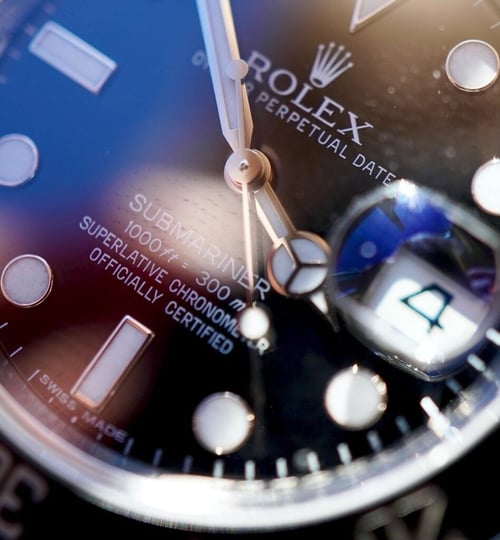When you’re exploring the world of luxury watches, there is a lot to learn. One thing you may notice is that many luxury watches have the designation “COSC Certified”. But what does that mean, exactly? COSC certification is certainly a coveted designation, and it is important if you want a top-quality watch. But how does it work? Who is responsible for this certification? These are some of the questions we’ll be answering in today’s blog.
COSC is an acronym for ‘Contrôle Officiel Suisse des Chronomètres’. This organisation acts as a third party to determine the accuracy and precision of luxury watches using several parameters. In English, this organisation is translated as the Official Swiss Chronometer Testing Institute. The standards necessary for this certification are set quite high, but if a luxury watch company wants to enter the upper echelon of quality, getting this certification is a must. Let’s take a quick look at the history of this prestigious organisation.
Although the COSC wasn’t the first to test watch movements, they’ve certainly become the trusted name in movement testing. Testing the precision of watch movements dates back to the 1800s, but the seeds of the COSC wouldn’t be planted until 1878. In the late 1870s, there were offices for watch movement testing across Switzerland in the towns of Bern, Geneva, Neuchâtel, Soleure, and Vaud. However, all of these offices had different criteria for determining the accuracy of these timepieces.
In 1973, the idea was proposed to form a single organisation with agreed-upon standards. The non-profit COSC was formed and would test all Swiss watch brands ever since. The COSC currently has three labs in Biel, Le Locle, and Saint-Imier.

As mentioned, it isn’t an easy feat to go through COSC testing and come out the other side with a certification. There are various tests that are required with very little room for error. The COSC tests the movements of watches, rather than the watches themselves. For instance, Rolex wouldn’t send them their latest Submariner to test, but they would send them their in-house Calibre 3130 testing to earn the certification. The lab conducts their tests, looks at the quality of the movement, and determines if the movement deserves a COSC certification. The COSC’s involved testing process means that only the highest quality watch brands are able to send in their movements for testing and certification.
With that in mind, what kind of tests do these watches have to pass? Let’s take a look at what makes a movement a COSC-certified movement.
First is the average daily rate test. This test compares the time on the dial to the atomic standard. The daily deviation of the watch from atomic time is measured in ±1/10s of a second. The values of these deviations are then averaged to see if the movement is faster or slower than atomic time. The average is compiled through ten days of testing. This measurement indicates the accuracy of a timepiece. For watch movements greater than 20mm in diameter, the average daily rate needs to be between minus-four and plus-six seconds/day to achieve COSC certification.
The next test is the mean variation in rates. This test is meant to measure the consistency of the rate. Meaning the results from the previous test should remain consistent in their deviations from the atomic standard. In other words, the mean variation of rates measures how much the movement deviates from its own timekeeping. The COSC will measure this parameter over the course of two consecutive days to see the variation. The variation across those two days is then measured (ex: 0.4 seconds slow on one day and 0.9 seconds slow on the second = 0.5 variation). This process is repeated over ten days and the variations are averages to find the mean variation in rates. In order to pass COSC certification standards, the mean variation needs to be equal to or less than two seconds/day.
The greatest variation in rates measures the variation in the daily rate in any single position over the course of two days. To pass the COSC certification the greatest variation in rates needs to be equivalent to or less than five seconds/day.
The rate variation in horizontal and vertical positions is the next test to determine a watch movement’s precision and accuracy. This test essentially ensures that a movement is able to maintain accuracy despite the differing effects of gravity. The watch will be tested in both flat and hanging positions and the variations will be compared. To pass the COSC certification the difference must be between minus-six and plus-eight seconds/day.
Temperature can also have an effect on the accuracy of a watch movement. The COSC will test this parameter by looking at rate variation at 8 and 38 degrees Celsius. The rate is divided by 30 to see the variation in rates per temperature degree. To pass this test, the COSC mandates the variation be within ±0.6 seconds/day per degree.
Finally, the COSC will test how the position and temperature testing has affected the movement through the process. The rate at the end of the test will be compared to the rate at the beginning of the test. On the 15th day of testing, the daily rate will be compared to the first two days’ rates. The difference between the first two-day average and the 15th-day daily rate must be between minus-five and plus-five seconds to pass COSC certification.
If you’ve always wanted an incredibly precise luxury timepiece of your own, choose BQ Watches. We carry a wide variety of COSC-certified watches including Rolex, Omega, Breitling, Tudor, Panerai, and many more.
Please enjoy browsing our inventoryfor your next timepiece, and let us know if there’s something in particular that we can source for you.